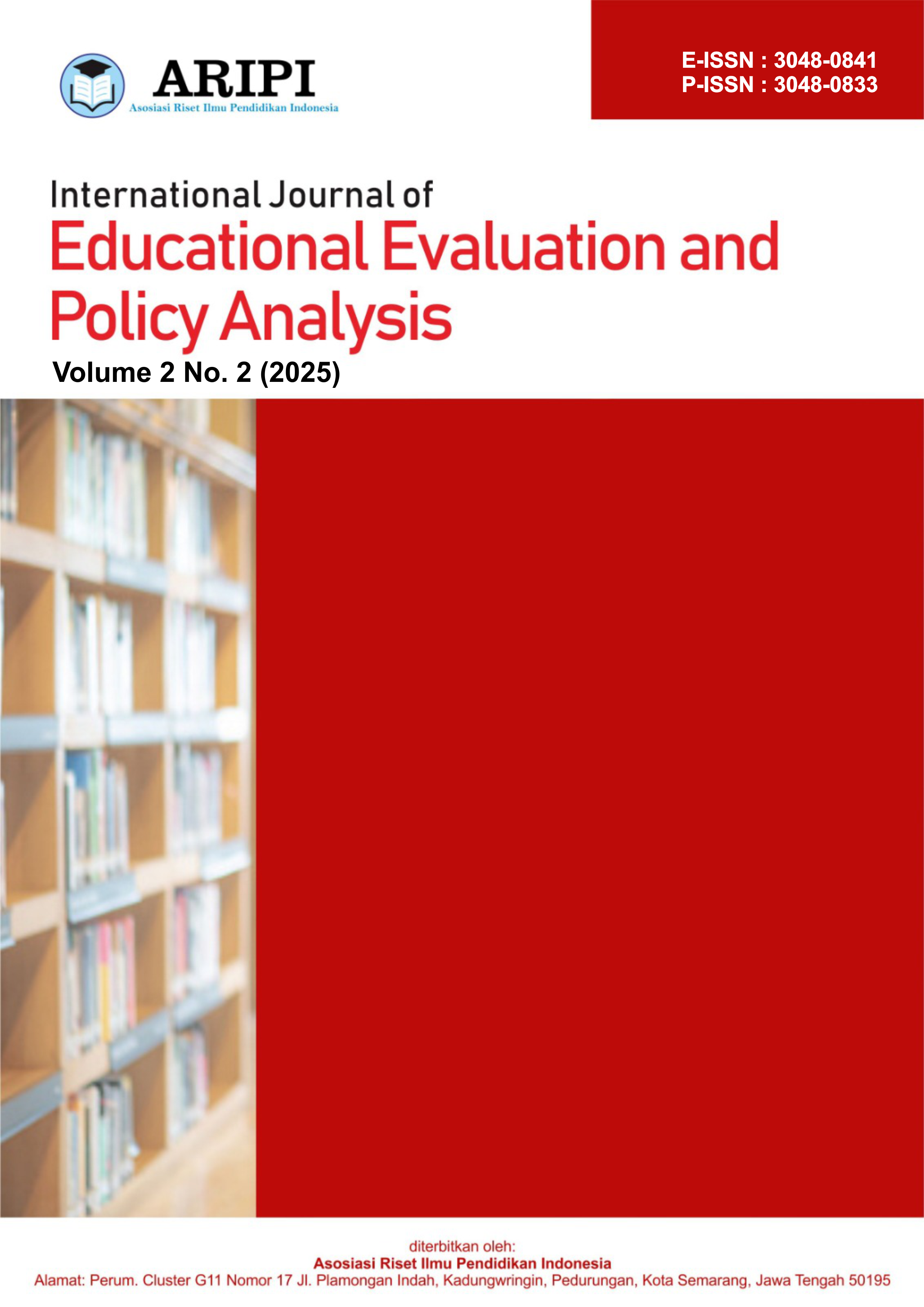Development of ELKPD Based on a Learning Model Sole Using Liveworksheet for Reaction Rate Material in Second Grade Senior High School
DOI:
https://doi.org/10.62951/ijeepa.v2i2.256Keywords:
E-LKPD, Learning Model SOLE, LiveworksheetAbstract
This study aims to produce a valid SOLE-based reaction rate electronic student activity sheet (E-LKPD) and to determine user responses to the resulting product. The research method used is research and development (R&D) using the ADDIE (Analysis, Design, Development, Implementation and Evaluation) development model. The research instrument is a validation sheet given to three validators and a user response sheet to one chemistry teacher of Senior High School 7 Pekanbaru and one chemistry teacher of Senior High School 11 Pekanbaru as well as 13 class XI students of Senior High School 7 Pekanbaru and 13 class XI students of Senior High School 11 Pekanbaru. The data analysis technique is carried out by calculating the percentage of validation assessment scores and user responses, the results of which are measured by an attitude assessment table. The results of the study indicate that the electronic student activity sheet (E-LKPD) based on SOLE that was developed has met the valid criteria by the material validator based on the aspect of content feasibility of 92.19%, SOLE model characteristics of 95.83%, pedagogic of 93.75%, linguistic of 95.83% and graphic of 95.83%. For the media validator based on the aspect of size of 100%, cover design of 92.50% and content design of 97.50%. While the user response based on teacher and student responses is in the very good criteria with scores of 94.79% and 88.05% respectively.
References
Almaki, S. M. (2024). Perspective the Implementation of Self-Organized Learning Envirnment (SOLE) Via Mobile Devices. International Journal of Mobile and Learning.
Bombang, & Viktor. (2022). Pengembangan LKPD Elektronik Materi Bangun Ruang Sisi Datar Menggunakan Aplikasi Liveworksheet Pada Siswa Kelas VIII SMP Negri 17 Malang. Jurnal Terapan Sains.
BSNP. (2006). Permendiknas RI No. 22 Tahun 2006 Tentang Standar Isi Untuk Satuan Pendidikan Dasar Dan Menengah. Jakarta: Rineka Cipta.
Fitriah, & Wardana. (2019). Profil Lembar Kerja Peserta Didik (LKPD) Unsur, Senyawa, Dan Campuran Dengan Pendekatan STEM. Jurnal Zarah, 7(2), 86–92. Jurnal Zarah, 7(2), 86–92, 86–92.
Fuadah, L. (2021). PENGEMBANGAN LKPD ELEKTRONIK (E-LKPD) BERBASIS PROBLEM BASED LEARNING (PBL) BERMUATAN ETNOSAINS PADA MATERI REAKSI REDOKS KELAS X DI MAN 1 CIREBON. Thesis. Semarang: Universitas Islam Walisongo.
Hasanah, N. (2021). Pengaruh Model Pembelajaran Sole Melalui Aplikasi Google Classroom Terhadap Kemampuan Disposisi Matematis. Jurnal Pendidikan Sosial Dan Sains, 14-19.
Hassan, P. (2020). Identifikasi Kemampuan Berpikir Kritis Siswa Dengan Menggunakan Five-Tier Multiple Choice Pada Materi Hidrolisis Garam. Hydrogen: Jurnal Kependidikan Kimia, 8(2), 74-84.
Herawati, E., Gulo, F., & Hartono. (2016). Pengembangan Lembar Kerja Peserta Didik (Lkpd) Interaktif Untuk Pembelajaran Konsep Mol Di Kelas X Sma. Jurnal Penelitian Pendidikan Kimia, 3(2), 168-178.
Hidayat, I. (2022). Pengembangan E-Lkpd Dengan 3d Pageflip Profesional Berbasis Self Organized Learning Environments (Sole) Pada Materi Larutan Penyangga. Thesis. Tanjung Pinang: UNIVERSITAS MARITIM RAJA ALI HAJI.
JK, A., & Yuliani , Y. (2021). Pengembangan Lembar Kerja Peserta Didik Elektronik (E-LKPD) Berbasis Inkuiri Pada Submateri Fotosintesis Untuk Meningkatkan Kemampuan Argumentasi Peserta Didik. . Berkala Ilmiah Pendidikan Biologi (Bioedu), 10(3).
Kamid. (2021). Pengembangan Soal Higher Order Thinking Skills Berbasis Budaya Jambi. Jurnal Cendekia: Jurnal Pendidikan Matematika, 5(2), 1793-1806.
Lestari, A. D. (2023). Pengembangan E-Lkpd Berbasis Literasi Sains Dengan Model Pembelajaran Self Organized Learning Environment (Sole) Pada Pokok Bahasan Asam Basa. Thesis. Serang: Repository Universitas Sultan Ageng Tirtayasa.
Mahnun, N. (2019). Media Pembelajaran (Kajian Terhadap Langkah-Langkah Pemilihan Media Dan Implementasinya Dalam Pembelajaran). Annida, 37(1), 27-35.
Martharefa, P. (2017). Deskripsi Pemahaman Konsep Siswa Pada Materi Laju Reaksi. Jurnal Untan.
Nurhayanti, K., Ayu, G., & Pramitra, A. (2023). Penerapan Model Pembelajaran Self Organized Learning Environment Dalam Pengembangan Soft Skill Mahasiswa. Jurnal Pendidikan Masyarakat.
Putri, M. (2024). Pengembangan E-LKPD Berbasis Website Liveworksheets Dengan Model Discovery Learning Pada Pembelajaran IPAS Di Sekolah Dasar. SITTAH: Journal of Primary Education, 17-32.
Ramadhani, A., & Setiawan, D. (2024). The Development of Mobile Learning Based on The SOLE Learning Model to Train Technology Literacy and Enhance Student’s Cognitive Learning Outcomes. AIP Conference Proceedings. Johor, Malaysia: American Institute of Physics.
Riduwan. (2008). Skala Pengukuran Variabel-Variabel Penelitian. Bandung: Alfabeta.
Suprihatin, & Manik. (2020). “Guru Menginovasi Bahan Ajar Sebagai Langkah Untuk Meningkatkan Hasil Belajar Siswa. Jurnal FKIP Universitas Muhammadiyah Metro, 65-72.
Yusuf, & Syamsu. (2016). Psikologi Perkembangan Anak Dan Remaja. Bandung: PT Remaja Rosda Karya.
Zein, F. A., & Musyarofah. (2024). Pengembangan Elektronik Lembar Kerja Peserta Didik (E-Lkpd) Interaktif Menggunakan Wizer.Me Pada Pembelajaran Ips. Prima Magistra: Jurnal Ilmiah Kependidikan, 5(1), 57-68.
Downloads
Published
Issue
Section
License
Copyright (c) 2025 International Journal of Educational Evaluation and Policy Analysis

This work is licensed under a Creative Commons Attribution-ShareAlike 4.0 International License.




